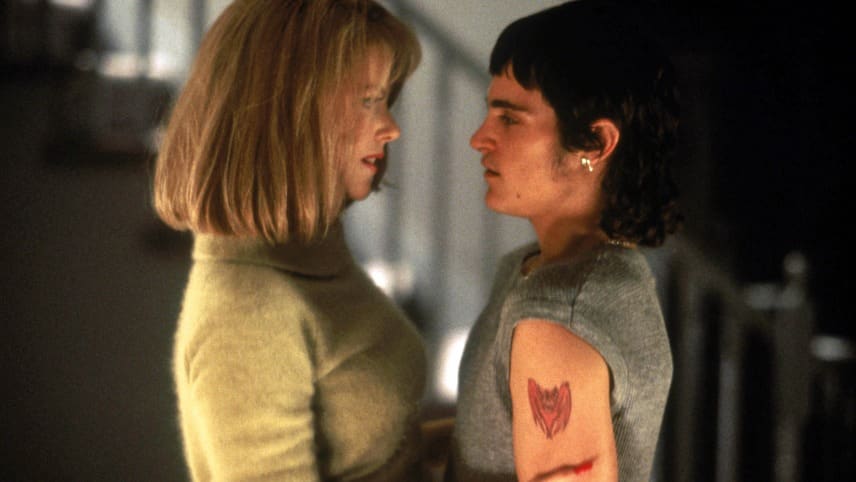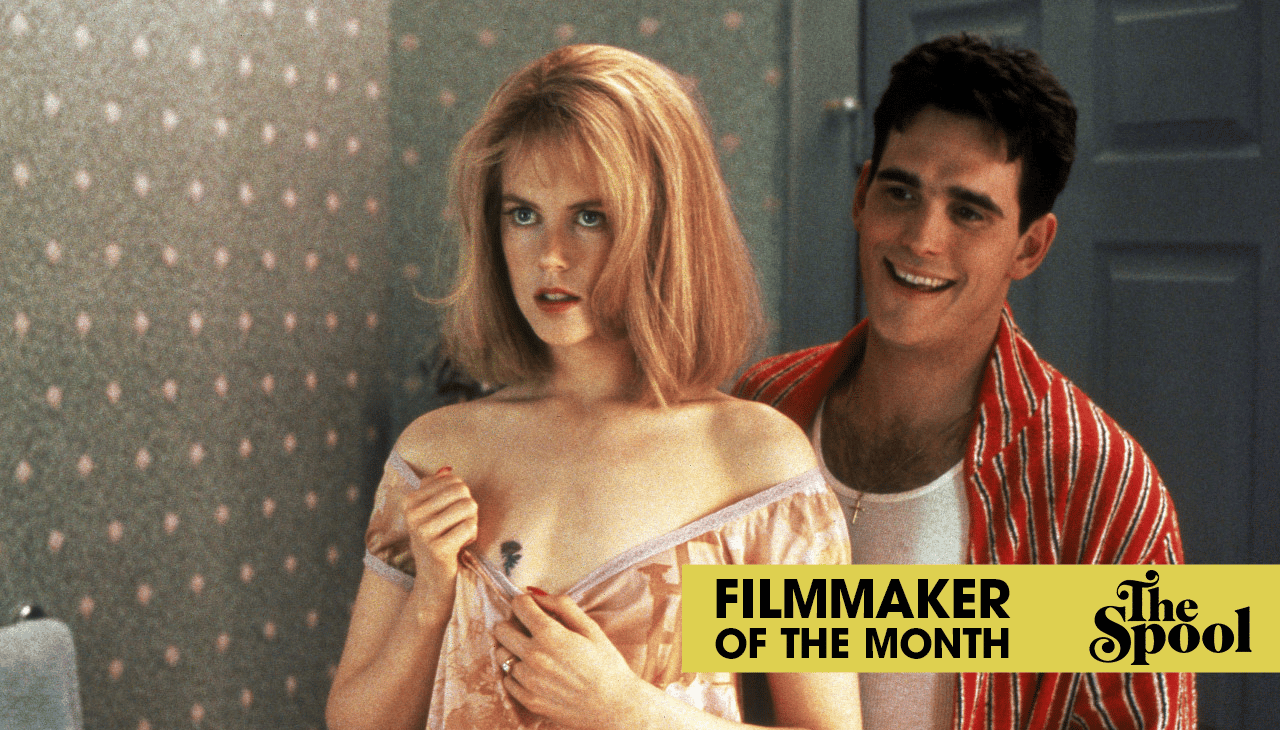Every month, we at The Spool select a filmmaker to explore in greater depth — their themes, their deeper concerns, how their works chart the history of cinema and the filmmaker’s own biography. For June, we celebrate the birthday (and the sensitive, insightful eye) of Gus Van Sant. Read the rest of our coverage here.
Vanity and self-absorption are perpetually the flaws of the younger generation, while the rest of us sit in smug judgment of their obsession with selfies, and sharing every facet of their lives with strangers. We conveniently forget that humans are, by nature, fascinated by our own images. Oh sure, we may talk a good game about being camera-shy, not enjoying our pictures being taken or whatever, but most of us, we daydream about being the stars of our very own shows, the eyes of the world upon us, looking with equal parts fascination and adoration. Gus Van Sant’s To Die For is a pitch-black comedy about what happens when that fantasy leads to deception and murder.
Written by Buck Henry, and based on Joyce Maynard’s novel of the same name, To Die For is based on the 1990 murder of Gregg Smart, shot to death by his wife’s teenage lover, who was manipulated into believing Smart was abusive. Much like the Amy Fisher and Susan Smith cases, Smart’s murder became a subject of worldwide interest at least as much for the salacious details surrounding the perpetrator of the crime as the crime itself. Pamela Smart, pretty and well-spoken, welcomed any opportunity to talk about herself on camera, even if it ultimately made her look worse. Even as recently as 2014, she appeared in an HBO documentary, continuing to profess her innocence. The camera loves her, and she loves it right back.
The fictionalized version of Pamela Smart in To Die For is Suzanne Stone, played by Nicole Kidman. Up to this point Kidman hadn’t really broken out of pretty wife/woman in peril roles, but here, however, playing her first villain, she’s bone-chilling, without ever resorting to violence or even raising her voice. Suzanne is pathologically ambitious, with a single-minded desire to become a television reporter, even if she can barely remember Mikhail Gorbachev’s name. For reasons known only to her, she chooses to stay in the all too accurately named town of Little Hope, New Hampshire and marry Larry Maretto (Matt Dillon), whose family owns the local bar.
Larry could have any woman he wants, but he only has eyes for Suzanne, despite the fact that there’s not a single thing that looks, sounds, or feels authentic about her. Even her conversations with family members sound phony and scripted, like something an alien thinks a normal human being would say. She’s a spiritual sister to Amy Dunne in Gone Girl, and, like Amy, only those outside her immediate orbit, like Larry’s sister (Illeana Douglas), can see her for who she really is, but no one listens to them until it’s too late.
Up to this point Kidman hadn’t really broken out of pretty wife/woman in peril roles, but here, however, playing her first villain, she’s bone-chilling, without ever resorting to violence or even raising her voice.
Suzanne is so career-driven that she uses her honeymoon as an opportunity to network (“network” meaning “allow herself to be groped by a conference speaker”), but Larry would rather see her settle down and have babies. Suzanne is all too happy to spend his money to maintain the artificial “as seen on TV” lifestyle she desires, which includes showing up for family pool parties wearing a business suit, as it becomes apparent that she and Larry have conflicting plans for their future. In fact, they have nothing at all in common, except for both thinking the sun shines out of Suzanne’s ass, and it’s not very long before those differences drive a wedge into their already unlikely relationship.
Without anyone her own age to talk to (because women like Suzanne don’t have real friends), she turns to the three teenage subjects of a documentary she’s trying to make, juvenile delinquent Russell (Casey Affleck), shy, awkward Lydia (Alison Folland), and even more shy and awkward Jimmy, played by Joaquin Phoenix, so young he looks like a newly hatched chick, but already exhibiting that signature sinister energy. It’s the first time anyone has ever really paid attention to them and their bleak, working class lives, and Suzanne’s hold over the trio of gullible teens is immediate and fierce. She confides in them about her unhappy marriage (without being entirely honest about it), and pushes all sorts of unimaginable boundaries, before very deliberately drawing Jimmy, who can barely speak in her presence, into an affair.
Kidman is aggressively sexy in her scenes with Phoenix, but a little scary too, and you expect their sex scenes to end with her chomping his head off like a Tootsie Pop. Phoenix is doing remarkable work here, playing Jimmy as equally turned on and frightened by Suzanne, who he continues to call “Mrs. Maretto,” even after they begin sleeping together. Though they’d deny it, Jimmy and Larry are really very similar. Both are small town blue collar boys, well-meaning but not particularly bright. Both are gobsmacked by Suzanne’s beauty and intelligence, to the point where neither of them see that she’s dead behind the eyes, and that she isn’t smart so much as sly. Neither of them realize that Suzanne doesn’t love them, can’t love them, because she only loves herself. Their primary difference, other than age, is that Jimmy is slightly dumber than Larry, and so it’s all too easy for Suzanne to convince him to murder Larry, with Russell and Lydia’s help.

Suzanne plays the role of the recent widow all too well, even playing it up for the television cameras at Larry’s funeral. Coldly cutting off Jimmy and the others, she seems offended at the very idea that they expect her to hold up her end of the bargain and keep the promises she made to them. She’s confident that no one would ever believe a bunch of poor teenage losers over her. Suzanne’s downfall, of course, is that she simply cannot stop talking about herself, not when a camera is pointed in her direction, not ever. In the end, it’s passive, lonely Lydia, who may love Suzanne most of all, who agrees to wear a wire as Suzanne traps herself in her own ceaseless, self-obsessed word vomit.
With To Die For, Van Sant and Henry (who appears in a small role as a high school teacher) worked together to create one of the best, subtly malevolent comedies of the 90s. It doesn’t just satirize our own, very human need to be the center of attention, but also media obsession, and the timeless tale of beauty being mistaken for goodness and purity. Suzanne basing her choices in clothing and home decor solely on what she’s seen on TV and in magazines, rather than her own taste (if she has any) is prescient of today’s “influencer” culture, when social media “stars” pass off clearly staged photos of perfect homes and spotless children as their authentic selves. Jimmy seems almost too stupid to live at times (such as when he thinks “your dick is bigger than your brain” is a compliment), but let me remind you: this is based on a true story, where the primary difference is that, in real life, Pamela Smart had no grand dreams of TV stardom. She just wanted her husband out of the way.
Perhaps the most cutting observation in To Die For comes at the very end, when we realize that nobody’s grown, and nobody’s learned anything. Rather than wait for justice, Larry’s father has Suzanne killed, her youth and beauty captured in ice forever. Jimmy, his metalhead hair shorn down and looking more vulnerable than ever in prison, still dreams of moving to California with the woman he loves, her promises to him finally fulfilled. Finally, Lydia, her image multiplying several times, smugly boasts that she has dozens of offers to appear on television to tell her story, offers she’s all too eager to take, because, as Suzanne once said to her, “What’s the point of doing anything worthwhile if nobody’s watching?”

